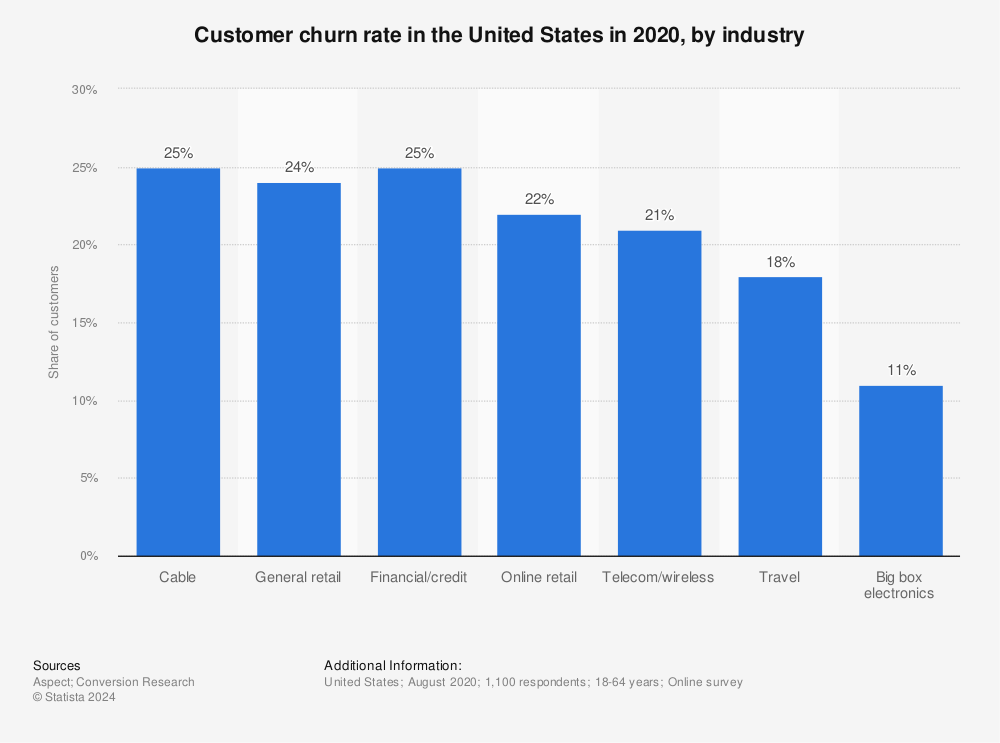All companies have more or less loyal customers and they also face the churn of some of them.
This is not an end in itself because not all customers can be loyal except in a perfect world.
Do what you do so well that they will want to see it again and bring their friends.
Walt Disney
Until proven otherwise, the goal of any business is obviously to reduce customer churn as much as possible, and that goes without saying, to retain as many new customers as possible.
It is therefore essential to put in place precise measures to reduce this attrition rate and you can already start by asking yourself the right questions.
How high is the attrition rate in my business? What means are currently being implemented to overcome this? Which new tools can I add to my workflow to have a low customer churn rate?
What is meant by Customer Churn?
There are several terms that define customer churn such as churn rate, attrition rate, or customer attrition.
The customer churn is quite simply a rate that is defined when one of your customers no longer wants to do business with your company. In other words, it’s the opposite of your retention rate,
In other words the sum of the retention rate and attrition rate is 100%.
Attrition = Lost customers | Retention = Kept customers
If you have a SaaS business, you can set this as the percentage of customers paying for your service who end their subscription within a set period.
We will focus in this article on customer churn but there is also employee churn which is none other than the percentage of employees who quit their job over a defined period.
Learn more: How to improve you customer retention rate?
Why should you consider Customer Churn?
Customer attrition is an indicator that, like customer retention, must imperatively be measured in order to have an idea of profitability and the quality of your business.
It is important to note that this indicator will not give you any details about the quality and type of customers leaving.
However, calculating your churn rate is an indicator that can also tell you about the satisfaction rate of your customers.
If your retention rate is very low, there is a good chance that your satisfaction rate is very high since you are offering a very good quality of product or service.
This way of seeing the churn rate and your customer loyalty will allow you certain sustainability of your business with a growing turnover.
We can also look at the attrition rate by industry.
Here, we have the customer churn rate by industry in the United States for the period of August 2020.

Statista
Over the years, this rate tends to increase in all industries because of the change in habits in the way people consume, particularly on the Internet.
It is therefore increasingly important to pay attention to this attrition rate in order to reduce it as much as possible.
See how can Feedier help you improve your churn rate
What are the causes of your customer churn?
There are many reasons that can be behind the increased customer churn and your business is not the only one of them.
Your customers are turning to a competing product/service
You are certainly not the only one in your industry to offer a more or less similar service. Despite having a unique value proposition, your customers are always tempted to analyze the services offered by your competitors.
What can sometimes make them change their mind is a lower price than what you are offering, an additional feature that you do not offer, improved quality of service, and many other causes.
As said previously, consumption patterns have evolved with the internet, as have sales methods and marketing techniques.
Your customers are surrounded by advertisements, offers, emails, and all other means to encourage them to consume products or services that may turn out to belong to your competitors.
In addition, products and services have become much more accessible. Subscriptions require less and less commitment over a defined period, you are free to cancel at any time.
If we take the case of a phone operator, commitments over a period of a year or two are less and less frequent, and there is a constant price war and the quality of the services offered.
Platforms have made it their business since they offer to compare these different services according to the price and the offers they offer. It is also a cause of the increased attrition rate.
Your customer experience is not optimized
As we said earlier, churn is also an indicator of your customers’ satisfaction. Your customers’ satisfaction says a lot about the experience they had when using your product or service.
Customer experience is therefore a factor that can drive your attrition and retention rates. If a customer has a bad experience with your business, it can be very negative for you, especially if it is a loyal customer who has trusted you for a long time.
They will be more disappointed and there is a good chance that they will share their dissatisfaction with their entourage, and this is really not good for your reputation.
The evolution of your industry and customer needs.
Your industry, like many others, is most certainly in constant evolution. If your churn rate is increasing, the problem is certainly that you are not adapting to this evolution and to the new needs of your customers.
A very concrete example to stay in the same sector as mentioned above, let’s take the case of smartphones.
With the evolution of technologies, the screens of phones are much larger than before, there is almost no friction between the digital interaction and the smartphone, you will find only two or even three buttons on the edges of your device.
If the Apple brand, not to mention Apple, had not followed this evolution and had remained on its first iPhone model with a small screen, no possibility of filming, do you think the firm would still be relevant?
For your product or service, it’s the same thing, adapting to the demands of your customers, to their needs, and to the evolution of your industry, are points to respect in order to continuously satisfy your customers.
How to reduce your attrition rate?
There are still many causes for your high attrition rate, so it is important to analyze your business and your customer base.
But to reduce this attrition rate, here our 3 advice to you:
Analyze and improve your customer experience
As we have seen, the customer experience is a key point in customer satisfaction.
In order to know what your customers think when they interact with your business, it is necessary to ask for their feedback at key moments of their purchase and user journey.
If you ask your customers about how they feel about using your product or about key points in your business at the right time, you will first know more about the quality of what you offer, but it will also be a way to know what needs to be improved in order to enhance the experience.
Asking for feedback will also create a long-term relationship with your customers, if they respond to your forms and you take their opinions into account when making changes to your product/service, then they will feel listened to and develop their attachment to your brand.
Within your feedback forms, you need to add questions such as NPS (Net Promoter Score) or CSAT (Customer Satisfaction) in order to collect and analyze data. The goal here is to get a global view of their experience.
That brings us to the next point.
Constantly improve your product or service.
Once you know more about the negative points of your business, once you know the factors of dissatisfaction of your customers, you will be able to implement the necessary devices to improve your product/service in order to lead to operational excellence.
If the essential questions have been asked in your questionnaires, you will know exactly what needs to be improved to increase customer satisfaction and therefore their loyalty.
Customer service and ongoing support is essential
Customer service is essential from the first interaction to the loyalty of your customer. It is important to accompany the customer in every step of the journey so that he leaves with a great experience from using your product or service.
Let’s continue to pretend that you are developing a SaaS, from the moment your new user signs up, you must be sure that your onboarding is clear and puts all the cards in the hands of this user so that he has the possibility to exploit your tool to 100%.
There are many different ways to support your user, including one that allows you to stay in regular contact with them, which is email.
Send your blog newsletter, nurture with tips, white books, valuable content that could bring value to your user and allow him to discover features of your tool that he may not have used until now. This can be very beneficial for his experience but also to reduce the attrition rate of your customers.






